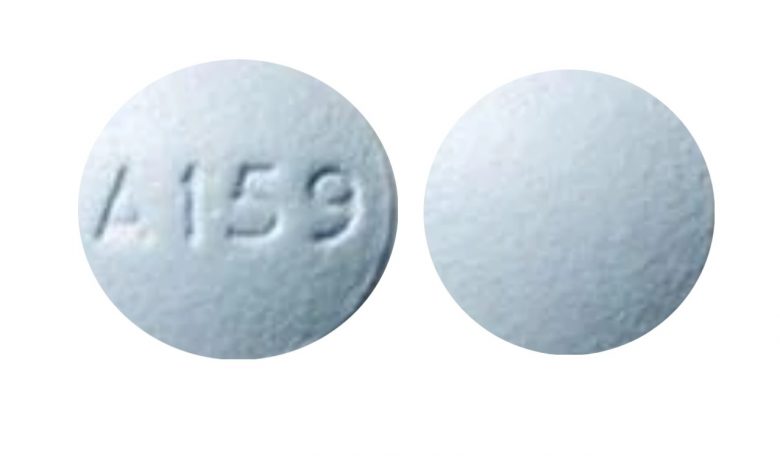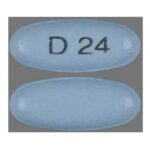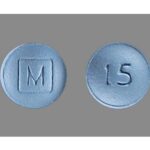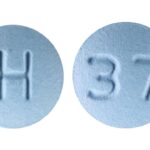Blue A159 Pill: Uses, Dosages, Side Effects, Interactions

What does the blue A159 pill contain?
The blue round pill with the imprint A159 has been identified as Bupropion Hydrochloride Extended-Release (SR) 100 mg supplied by Anchen Pharmaceuticals, Inc. An extended-release drug is released into your system slowly over time.
Bupropion is an antidepressant medication that works in the brain. It is approved for the treatment of the major depressive disorder (MDD), seasonal affective disorder (SAD), and to help people quit smoking (smoking cessation). Bupropion 100 mg is not a controlled substance under the Controlled Substances Act (CSA).
Bupropion may also be helpful when prescribed “off-label” for bipolar disorder, attention deficit hyperactivity disorder (ADHD, and sexual dysfunction due to SSRI antidepressants. “Off-label” means that it hasn’t been approved by the Food and Drug Administration for this condition. Your mental health provider should justify his or her thinking in recommending an “off-label” treatment. They should be clear about the limits of the research around that medication and if there are any other options.
How it works
The blue A159 pill belongs to a class of drugs called antidepressants. A class of drugs is a group of medications that work in a similar way. These drugs are often used to treat similar conditions.
Blue A159 pill works by increasing the activity of natural chemicals in your brain. Your nerves use these chemicals to send messages to each other. These chemicals include dopamine and norepinephrine.
What do I need to tell my doctor BEFORE I take blue A159 Tablets?
• If you are allergic to this medicine (bupropion extended-release tablets); any part of this medicine (bupropion extended-release tablets); or any other drugs, foods, or substances. Tell your doctor about the allergy and what signs you had.
• If you have ever had seizures.
• If you drink a lot of alcohol and you stop drinking all of a sudden.
• If you use certain other drugs like drugs for seizures or anxiety and you stop using them all of a sudden.
• If you have ever had an eating problem like anorexia or bulimia.
• If you have any of these health problems: Kidney disease or liver disease.
• If you have taken certain drugs for depression or Parkinson’s disease in the last 14 days. This includes isocarboxazid, phenelzine, tranylcypromine, selegiline, or rasagiline. Very high blood pressure may happen.
• If you are taking any of these drugs: Linezolid or methylene blue.
• If you are taking another drug that has the same drug in it.
This is not a list of all drugs or health problems that interact with this medicine (blue A159 pill).
Tell your doctor and pharmacist about all of your drugs (prescription or OTC, natural products, vitamins) and your health problems. You must check to make sure that it is safe for you to take this medicine (blue A159 tablets) with all of your drugs and health problems. Do not start, stop, or change the dose of any drug without checking with your doctor.
What are some things I need to know or do while I take blue A159 Tablets?
For all patients taking this medicine (A159tablets):
• Tell all of your health care providers that you take this medicine (bupropion extended-release tablets). This includes your doctors, nurses, pharmacists, and dentists.
• Avoid driving and doing other tasks or actions that call for you to be alert or have clear eyesight until you see how this medicine affects you.
• This medicine may affect certain lab tests. Tell all of your health care providers and lab workers that you take this medicine.
• Do not stop taking this medicine all of a sudden without calling your doctor. You may have a greater risk of side effects. If you need to stop this medicine (bupropion extended-release tablets), you will want to slowly stop it as ordered by your doctor.
• High blood pressure has happened with this medicine (bupropion extended-release tablets). Have your blood pressure checked as you have been told by your doctor.
• This medicine may raise the chance of seizures. The chance may be higher in people who have certain health problems, use certain other drugs, or drink a lot of alcohol. Talk to your doctor to see if you have a greater chance of seizures while taking this A159 tablet.
• Avoid drinking alcohol while taking this medicine A159 tablet.
• Talk with your doctor before you use other drugs and natural products that slow your actions.
• It may take several weeks to see the full effects.
• This medicine is not approved for use in children. Talk with the doctor.
• If you are 65 or older, use A159 pills with care. You could have more side effects.
• Tell your doctor if you are pregnant, plan on getting pregnant, or are breastfeeding. You will need to talk about the benefits and risks to you and the baby.
If you smoke:
• Not all products are approved for use to help stop smoking. Talk with the doctor to make sure that you have the right product.
• New or worse mental, mood, or behavior problems have happened when bupropion has been used to stop smoking. These problems include thoughts of suicide or murder, depression, forceful actions, fury, anxiety, and anger. These problems have happened in people with and without a history of mental or mood problems. Talk with the doctor.
How is blue A159 best taken?
Use blue A159 tablets as ordered by your doctor. Read all information given to you. Follow all instructions closely.
• Do not take this medicine blue A159 tablets more often than you are told. This may raise the risk of seizures. Be sure you know how far apart to take your doses.
• Take in the morning if taking once a day.
• Take with or without food.
• If you are not able to sleep, do not take blue A159 tablets too close to bedtime. Talk with your doctor.
• Swallow whole. Do not chew, break, or crush.
• Keep taking blue A159 tablets as you have been told by your doctor or other health care provider, even if you feel well.
• If you have trouble swallowing, talk with your doctor.
What do I do if I miss a dose?
• Skip the missed dose and go back to your normal time.
• Do not take 2 doses at the same time or extra doses.
Detailed Bupropion dosage information
What are some side effects that I need to call my doctor about right away?
WARNING/CAUTION: Even though it may be rare, some people may have very bad and sometimes deadly side effects when taking a drug. Tell your doctor or get medical help right away if you have any of the following signs or symptoms that may be related to a very bad side effect:
• Signs of an allergic reaction, like rash; hives; itching; red, swollen, blistered, or peeling skin with or without fever; wheezing; tightness in the chest or throat; trouble breathing, swallowing, or talking; unusual hoarseness; or swelling of the mouth, face, lips, tongue, or throat.
• Signs of high blood pressure like very bad headache or dizziness, passing out, or change in eyesight.
• Feeling confused, not able to focus, or change in behavior.
• Hallucinations (seeing or hearing things that are not there).
• If seizures are new or worse after starting this medicine (bupropion extended-release tablets).
• Chest pain or pressure.
• Fast or abnormal heartbeat.
• Swelling.
• Shortness of breath.
• Change in hearing.
• Ringing in ears.
• Passing urine more often.
• Swollen gland.
• Trouble moving around.
• Some people may have a higher chance of eye problems with A159 tablets. Your doctor may want you to have an eye exam to see if you have a higher chance of these eye problems. Call your doctor right away if you have eye pain, change in eyesight, or swelling or redness in or around the eye.
• A very bad skin reaction (Stevens-Johnson syndrome/toxic epidermal necrolysis) may happen. It can cause very bad health problems that may not go away, and sometimes death. Get medical help right away if you have signs like red, swollen, blistered, or peeling skin (with or without fever); red or irritated eyes; or sores in your mouth, throat, nose, or eyes.
What are some other side effects of A159 Tablets?
All drugs may cause side effects. However, many people have no side effects or only have minor side effects. Call your doctor or get medical help if any of these side effects or any other side effects bother you or do not go away:
• Dizziness or headache.
• Constipation, diarrhea, stomach pain, upset stomach, throwing up, or feeling less hungry.
• Shakiness.
• Feeling nervous and excitable.
• Strange or odd dreams.
• Gas.
• Dry mouth.
• Trouble sleeping.
• Muscle or joint pain.
• Nose or throat irritation.
• Sweating a lot.
• A change in weight without trying.
• For some brands, you may see the tablet shell in your stool. For these brands, this is normal and not a cause for concern. If you have questions, talk with your doctor.
These are not all of the side effects that may occur. If you have questions about side effects, call your doctor. Call your doctor for medical advice about side effects.
You may report side effects to the FDA at 1-800-332-1088.
Overdose
If you think there has been an overdose, call your poison control center or get medical care right away. Be ready to tell or show what was taken, how much, and when it happened.
How do I store and/or throw out A159 Tablets?
• Store at room temperature protected from light. Store in a dry place. Do not store it in a bathroom.
• Keep all drugs in a safe place. Keep all drugs out of the reach of children and pets.
• Throw away unused or expired drugs. Do not flush down a toilet or pour down a drain unless you are told to do so. Check with your pharmacist if you have questions about the best way to throw out drugs. There may be drug take-back programs in your area.





